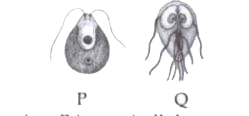Refer to the given dichotomous key. Identi fy P -T and select the incorrect statement.
I. (a) It is unicellular organism. - Go to II
(b) It is multicellular organism. Go to IV
II. (a) It possesses well organised nucleus. Go to III
(b) It lacks well organised nucleus. -P
III. (a) Nutrition is parasitic. -Q
(b) Nutrition is mixotrophic. -R
IV. (a) It possesses chlorophyll. - S
(b) It lacks chlorophyll. -T
P can convert lactose sugar of milk into lactic acid.
R could be Euglena which possesses cilia that helps in movement.
Q could be Plasmodium which causes malaria or it could be Entamoeba which causes amoebic dysentery in humans.
S could be a plant like pondweed whereas T could be a scavenger like vulture or a decomposer like Rhizopus.
The correct Answer is:B
Step by step video, text & image solution for Refer to the given dichotomous key. Identi fy P -T and select the incorrect statement. I. (a) It is unicellular organism. - Go to II (b) It is multicellular organism. Go to IV II. (a) It possesses well organised nucleus. Go to III (b) It lacks well organised nucleus. -P III. (a) Nutrition is parasitic. -Q (b) Nutrition is mixotrophic. -R IV. (a) It possesses chlorophyll. - S (b) It lacks chlorophyll. -T by Biology experts to help you in doubts & scoring excellent marks in Class 8 exams.
Updated on:21/07/2023Topper's Solved these Questions
- MICROORGANISMS : FRIEND AND FOEBook:MTG IIT JEE FOUNDATIONChapter:MICROORGANISMS : FRIEND AND FOEExercise:Exercise (Subjective Questions) (Long Answer Type)
Explore 5 Videos
- FOOTSTEPS TOWARDS NEET Book:MTG IIT JEE FOUNDATIONChapter:FOOTSTEPS TOWARDS NEET Exercise:MCQs
Explore 90 Videos
- REACHING THE AGE OF ADOLESCENCEBook:MTG IIT JEE FOUNDATIONChapter:REACHING THE AGE OF ADOLESCENCEExercise:Olympiad/ HOTS Corner
Explore 12 Videos
Similar Questions
Refer to the given dichotomous key and select the incorrect option regarding organisms P, Q, R and S.
I. (a) Animals with cellular level of body organisation. - __P__
(b) Animals with tissue/organ/ organ system level of body organisation. - Go to II
II. (a)Animals possessing bilateral symmetry. - Go to III (a)
(b)Animals possessing radial symmetry.- Go to III (b)
III. (a) True coelom is present. - Go to IV (a)
True coelom is absent. - Go to IV (b)
IV. (a) Notochord is present. __Q__
(b) Notochord is absent. - Go to V
V. (a) It is represented by medusa form. ____R___
(b) It is represented by polyp form. - ___S___
View SolutionA tissue made up of only one type of differentiated cells is
View Solution
Knowledge Check
Well organised nucleus is not found in
AProkaryotic cell,BEukaryotic cell,CPlant cellDNerve cell. "The mode of nutrition in parasitic organisms is
AheterotrophicBautotrophicCboth autotrohic and heterotrophicDnone of the aboveRefer to the given dichotomous key and select the correct option regarding P, Q, R, S and T.
I. (a) Genetic material is not enclosed in nucleus. - Go to II
(b) Genetic material is enclosed in nucleus. - Go to III
II. (a) Lacks cell wall. - P
(b) Possesses cell wall. - Q
III. (a) Unicellular organism - R
(b) Multicellular organism - Go to IV
IV. (a) Plant body is sporophytic and water is required for fertilisation. - S
(b) Plant body is sporophytic and water is not required for fertilisation. - TAP is motile whereas Q is non-motile.BR could be yeast or Chlamydomonas.CBoth S and T produce seeds for propagation of their species.DS could be Adiantum whereas T could be Riccia.
Refer to the given dichotomous key and answer the following questions.
I. (a) The cells of tissue have walls. - Go to II
(b) The cells of tissue do not possess wall. - Go to III
II. (a) Tissue made of one type of cells. - Go to IV
(b) Tissue, made of more than one type of cells. - Go to V
III. (a) The tissue lines the alveoli of lungs. -P
(b) The tissue forms shock absorbing cushion around some vital organs. - Q
IV. (a) Cells of tissue contain air cavities and it provides buoyancy. -R
(b) The tissue provides mechanical strength and flexibility to young dicot stems and petioles. - S
V. (a) Tissue conducts water. - T
(b) Tissue conducts organic solutes. - U
Select the incorrect option regarding tissues P, Q, R, S, T and U.
View SolutionRead the following statements.
A. Nerve cells do not have the ability of regeneration.
B. Nerve cells are one kind of muscle tissue.
C. No two nerve cells have same appearance.
D. Nervous tissue is a fluid tissue.
Which of the following is true?
View SolutionA : Source of SCP can be prokaryotic as well as eukaryotic organism.
R : SCP is obtained from unicellular organisms as well as multicellular organisms.
View SolutionThe organism having parasitic mode of nutrition is:
View SolutionStudy the given figures and select the correct statements regarding these.

(i) Organism P is a unicellular green alga.
(ii) Organism Q is a parasitic protozoan.
(iii) Organism Q causes diseases in human beings.
(iv) Both the organisms P and Q cannot synthesise their own food.
View Solution